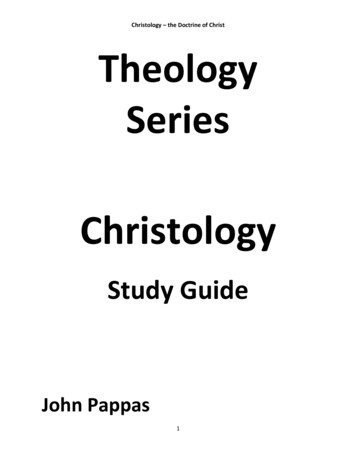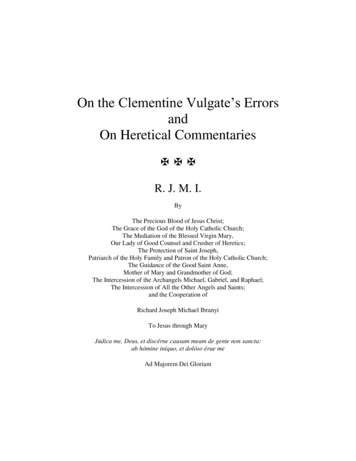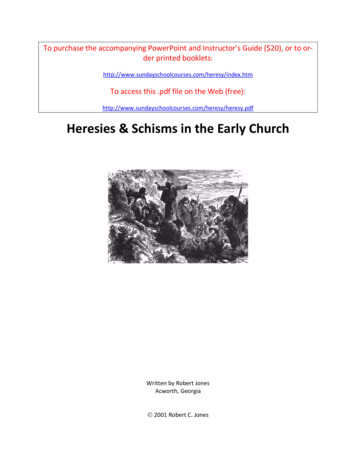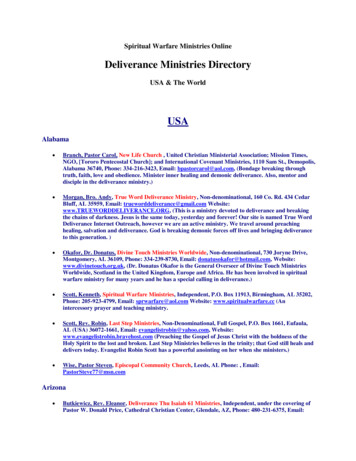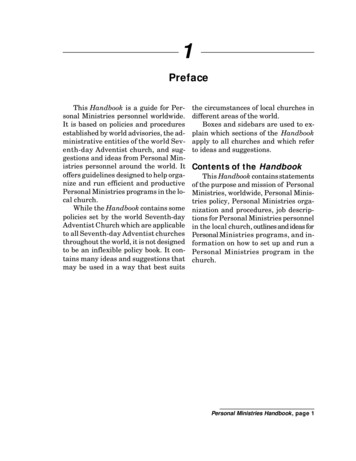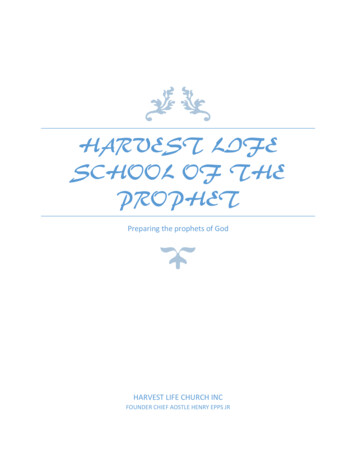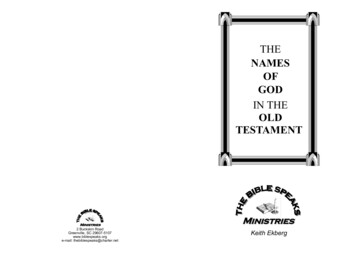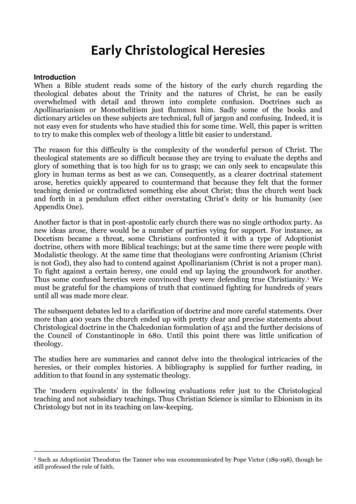
Transcription
Early Christological HeresiesIntroductionWhen a Bible student reads some of the history of the early church regarding thetheological debates about the Trinity and the natures of Christ, he can be easilyoverwhelmed with detail and thrown into complete confusion. Doctrines such asApollinarianism or Monothelitism just flummox him. Sadly some of the books anddictionary articles on these subjects are technical, full of jargon and confusing. Indeed, it isnot easy even for students who have studied this for some time. Well, this paper is writtento try to make this complex web of theology a little bit easier to understand.The reason for this difficulty is the complexity of the wonderful person of Christ. Thetheological statements are so difficult because they are trying to evaluate the depths andglory of something that is too high for us to grasp; we can only seek to encapsulate thisglory in human terms as best as we can. Consequently, as a clearer doctrinal statementarose, heretics quickly appeared to countermand that because they felt that the formerteaching denied or contradicted something else about Christ; thus the church went backand forth in a pendulum effect either overstating Christ’s deity or his humanity (seeAppendix One).Another factor is that in post-apostolic early church there was no single orthodox party. Asnew ideas arose, there would be a number of parties vying for support. For instance, asDocetism became a threat, some Christians confronted it with a type of Adoptionistdoctrine, others with more Biblical teachings; but at the same time there were people withModalistic theology. At the same time that theologians were confronting Arianism (Christis not God), they also had to contend against Apollinarianism (Christ is not a proper man).To fight against a certain heresy, one could end up laying the groundwork for another.Thus some confused heretics were convinced they were defending true Christianity.1 Wemust be grateful for the champions of truth that continued fighting for hundreds of yearsuntil all was made more clear.The subsequent debates led to a clarification of doctrine and more careful statements. Overmore than 400 years the church ended up with pretty clear and precise statements aboutChristological doctrine in the Chalcedonian formulation of 451 and the further decisions ofthe Council of Constantinople in 680. Until this point there was little unification oftheology.The studies here are summaries and cannot delve into the theological intricacies of theheresies, or their complex histories. A bibliography is supplied for further reading, inaddition to that found in any systematic theology.The ‘modern equivalents’ in the following evaluations refer just to the Christologicalteaching and not subsidiary teachings. Thus Christian Science is similar to Ebionism in itsChristology but not in its teaching on law-keeping.1Such as Adoptionist Theodotus the Tanner who was excommunicated by Pope Victor (189-198), though hestill professed the rule of faith.
2The various heresies examined in chronological orderGnosticism THE NAME: comes from the Greek gnosis, meaning ‘to know’. CHRISTOLOGICAL TEACHING: Christ is not the Supreme Being. Docetism. OTHER TEACHING: a complex syncretism of paganism, Oriental mysticism, occultism(astrology, magic), Christianity, Platonic dualism and other religions. Basic premise isthat matter is evil, the spirit is good (dualism). The Supreme Being has a feminine sideand is the ‘Mother-Father’. There are a series of divine emanations. Sophia (i.e.wisdom, sometimes identified as the Spirit) is the youngest of the divine beings and isfemale. Jesus was a product of Sophia and the Supreme Being, and is called an aeon.Sophia alone produced the Demiurge, equivalent to the OT Yahweh, who is imperfectand created the world, which is evil. Jesus was incarnated to teach the mysteries (secretknowledge, Gnosis) to Gnostics. Salvation is by knowing the mysteries (Gnosis). Someteach that Sophia is one of the 30 aeons and that these are finite beings, like angels.Some Gnostics (Marcion, Valentinus) taught that salvation comes from Christ who is anaeon who brought knowledge to men. Some Gnostics were ascetics while others werelibertarians. WORKS: Nag Hammadi codices discovered in 1945 plus other fragments and quotes inthe fathers. MAIN PROPONENTS: Originator said to be Simon Magus (Acts 8:9-24); i.e. the first topropagate these ideas in Christian circles in Rome. He deified himself and alsoproduced miracles by magic power. Basilides formed the Alexandrian cult. Hecombined Christianity with pagan mysteries, such as Egyptian Hermetism2, Orientaloccultism, Chaldean astrology, and Persian philosophy. Valentinus took over fromBasilides; both developed the idea of the ‘pleroma’ or the heavenly world consisting of adescending series of 30 ‘aeons’, or spiritual powers (angels),3 each creating a newheaven. Other angels also create a heaven until there are 365 of them. The descendingseries of aeons serves to distance the Supreme Being (‘Autopater’ or ‘self-father’) fromthe material creation which is evil. Other leaders include: Saturnilus, Marcion;Cerinthus, Menander; Ptolemaeus; Mani (Manichaeism4). The different sourcesdeveloped separate traditions and a wide variety of contradictory teachings; all thismakes evaluation of Gnosticism difficult. TIMESCALE: a significant problem from the time of the apostles to the third century(though remnants continued later than this). Hegesippus says that Gnosticismpredated Christ and was based upon seven Jewish heresies. COMBATED BY: Irenaeus (130-200), ‘Against Heresies’. Hippolytus (170-236), ‘TheRefutation of all Heresies’. Tertullian (160-225); Epiphanius (310-403). MODERN EQUIVALENT: New Age teachings. William Blake. Christian Science. Theosophyand Anthroposophy. Many modern Gnostic type cults, one has a magazine called‘Gnosis’. There is a sense in which any religious movement that is founded upon asyncretism of false religion with Christianity and which emphasises a secret knowledgefor the initiated is Gnostic.2Hermetism is Egyptian occultism based upon alchemy involving the Egyptian god Thoth and the Greek godHermes (Hermes Trismegistus). It has similarities with Theosophy and Rosicrucianism (which were basedupon it). It combines Greek thought (particularly Platonic dualism) with Eastern religion.3 Such as Phronesis (Prudence), Sophia (Wisdom) & Dynamis (Power).4 ‘Manicheism’ in the USA.
3DocetismThis was a facet of many Gnostics. Since matter is evil, then Christ could not have becomeflesh. Therefore, his body was only an appearance of human flesh, or a phantom. Christ didnot die on the cross but exchanged places with Simon of Cyrene at the last minute.MarcionismGnostic dualism. Chief emphasis was that the OT God is not the same as the NT God.Taught by Marcion (d. 160). Being a Docetist he denied Jesus’ human nature, but he alsodenied Jesus’ deity. Marcion was anti OT and anti-Semitic. He was opposed by Polycarp,Bishop of Smyrna (70-155) and Irenaeus. Marcion is famous for creating his own canon(centred on Paul’s writings) and forcing the church to consider a formal canon.ManichaeismA 3rd century form of dualistic Gnosticism propounded by Mani (216-276), or Manes,which became a world religion reaching as far as China by the 8th century. It became thestate religion of the Turkic Uigurs in the late 8th century. Certain Christian groups (theBogomils in the Balkans and Cathari in southern France) have been accused of beingGnostic and Manichaean but a true historical connection is doubtful and more likely to beRomanist propaganda utilised in its persecutions.Mani’s view of Christ was Gnostic and denied his resurrection, though Mani claimed to beChrist’s successor. Christ was called ‘the Brilliant Light’ and the story Jesus in the Gospelsis but an instance of the suffering of imprisoned eternal Light in matter (battle of dualism).Disciples were ascetics (abstaining from meat and sex) seeking gradual liberation. He alsotaught a millennial reign of Jesus after which the elect are reunited with the Light. Hisdeeply mythological teaching managed to absorb many Marcionites.Ebionism THE NAME: means ‘poor’ (Hebrew / Aramaic Ebion, ebyonim). CHRISTOLOGICAL TEACHING: Christ is just a man, though he is a prophet. OTHER TEACHING: Christian Judaisers who lived an ascetic life and celebrated aSaturday Sabbath; salvation was by keeping the Jewish law. They rejected most of theBible, especially Paul’s letters; though they did use Matthew’s Gospel. They alsorejected the virgin birth. They also wrote their own scriptures, such as ‘The Gospelaccording to the Hebrews’. WORKS: The Gospel according to the Hebrews; The Ascension of Isaiah; The Odes ofSolomon. MAIN PROPONENT: Most leaders are lost in history but Eusebius and Jerome confirmSymmachus as a late 2nd century Ebionite. TIMESCALE: from early church times to the 5th century. COMBATED BY: Epiphanius. MODERN EQUIVALENT: radical Jewish Root teachings; also a modern form of Ebionismin the USA. Christian Science, International Church of Ageless Wisdom, ReligiousScience, Unity School of Christianity.Dynamic Monarchianism or Adoptionism THE NAME: ‘One ruler’. ‘Monarchianism’ is used to denote the primacy of God theFather. A defence of the unity (monarchy) of the Godhead. CHRISTOLOGICAL TEACHING: Jesus was a ‘mere man’ (psilos anthropos) until he wasadopted by God to be his Son. Christ was only a man under the influence of God.
4 OTHER TEACHING: Chief doctrine is that there is only one God (monotheism) in an effortto reject the polytheism of Gnosticism, which taught that Christ was an immaterialaeon.MAIN PROPONENTS: Theodotus the Tanner of Byzantium & Theodotus the MoneyChanger taught that Jesus became divine at his baptism. Paul of Samosata (200-275)taught that from eternity the Logos was an impersonal spiritual force active, forexample, in Moses. When Jesus (born of a virgin) was baptised he was anointed by thisforce. He also taught a Gnostic Sophia Spirit in God. Both the Logos and Sophia wereimpersonal.TIMESCALE: Arose about 190 in Rome; developed in 3rd century.COMBATED BY: Epiphanius.MODERN EQUIVALENT: some Unitarians. Also Liberal theologians FriedrichSchleiermacher, Albrecht Ritschl, Adolph von Harnack, John AT Robinson.Modalistic Monarchianism or Modalism or Patripassianism or Sabellianism THE NAME: Patripassianism means, ‘the father suffers’. This is because what happens tothe Son happens to the Father also, since they are one and the same. CHRISTOLOGICAL TEACHING: Christ is simply a mode of the one God with no personalexistence of his own. OTHER TEACHING: God is one; the Father, Son and Spirit are modes of working (orexpressions) of the one God. MAIN PROPONENTS: Noetus; Epigonus; Praxeas; Sabellius. TIMESCALE: 3rd century. COMBATED BY: Hippolytus; Tertullian, ‘Against Praxeas’. MODERN EQUIVALENT: Oneness Pentecostals; Unitarianism. Branhamism (OnenessTheology of William Branham), Swedenborgianism.Arianism THE NAME: derives from its founder, Arius. CHRISTOLOGICAL TEACHING: The Son was created by God the Father, before time andfrom nothing, therefore, the Son cannot be pre-existent or eternal; he is a creature butnot one of the creatures. It denied that the Son was of one essence with the Father.Arius: ‘If the Father begat the Son, he that was begotten had a beginning of existence therewas a time when the Son was not.’5 OTHER TEACHINGS: The Logos is a created, divine manifestation (’reason’), not Christ, and is adifferent substance from the Father. Two parties developed: the first taught that Christ was created of like substance(homoiousios) to the Father (led by Arius); the other that Christ was made of asubstance unlike (anomoios) that of the Father (led by Aetius & Eunomius in the350s; i.e. ‘Eunomianism’ and ‘Anomoeans’). The Spirit is a created being. Despite this Arius called for prayer and worship to the Son and the Spirit andArians baptised in the name of the Father, Son and Holy Spirit. Intentions: to preserve monotheism and God’s transcendence. WORKS: none extant; sections found in quotes in other writings. MAIN PROPONENTS: Arius (256-336) a presbyter (pastor) at Alexandria. Lucian ofAntioch was the teacher of Arius (and many other Arians) and taught adoptionist and5 Quoting SocratesScholasticus.
5 subordinationist heresies before him (‘Lucianism’). Note that Arius claimed to be aBiblical Christian.TIMESCALE: The period of the main controversy was 318-381 but the problems causedby Arianism continued for centuries. Initially Arius was disciplined by Alexander,bishop of Alexandria, in a synod of 100 bishops from Egypt and Libya. Alexander wasthe first to use the term ‘homoousios’ in the debate, a key moment in theological historydeclaring that the Father and the Son are one substance (homoousios). After beingexcommunicated, Arius was supported by Eusebius of Nicomedia and Eusebius thehistorian. The Council of Antioch (325) condemned Arianism. The Council of Nicaea(325) condemned Arianism; stating that Christ, from eternity, is of one substance withthe Father. Attempts were made to compromise in a difficult political situation in 357 atSirmium suggesting the blander homoiousios (‘of similar nature’). Athanasius refusedto compromise, hence the saying, ‘Athanasius contra mundum’ (Athanasius against theworld). The western world compromised for a time and Arianism waxed and waned.After much complicated politics involving emperors, the Council of Constantinople(381) reaffirmed the Nicene position. In the 360s a new group known as theMacedonians, or the Pneumatomachi (‘Spirit fighters’), emerged. They accepted theSon as one substance with the Father but denied this of the Holy Spirit. Athanasius sawthis as another form of Arianism and launched a successful attack, causingConstantinople to also affirm the divinity of the Spirit. After Arianism was put downwithin the empire, it flourished outside it amongst the Goths since Ulfilas (themissionary to the Goths) was an Arian.6COMBATED BY: Alexander of Alexandria. After Nicaea, Alexander’s deacon Athanasiuscontinued the fight.MODERN EQUIVALENT: Jehovah’s Witnesses conform exactly; a similar position exists inChristadelphians and extreme Unitarians. Children of God, International Church ofAgeless Wisdom, Way International.COMPARISON: Simple heresy: Paul of Samosata taught that Christ was adopted by theFather at his baptism. Complex heresy: Arius taught that Christ is not eternallybegotten but is the first begotten of the Father and pre-existent.COMPARISON: Modalists taught that the Logos is identical to the Father. Adoptionistsdispensed with the Logos altogether. Arianism (and Lucianism): the Logos iscategorically different from the Father.CONCLUSION: Arianism was really a bridge between polytheism and monotheism.Athanasius cynically summed it up as (sic): ‘a Son who is no Son; a Logos who is noLogos; a monotheism that does not exclude polytheism. Two or three essences to beworshipped; although only one is really distinct from that of creatures. An indefinable being thatbecomes God only in that it becomes man, and that is neither God nor man.’7Apollinarianism THE NAME: comes from its founder, Apollinaris. CHRISTOLOGICAL TEACHING: The two natures of Christ could not exist within one person,therefore, the human nature had to be diminished; Christ cannot be fully God and fullyman at the same time. Therefore, Christ had one active principle alone, the divineLogos. Christ’s human flesh had no independent mind or will; the Logos replaced6 Ulfilas7was converted as a slave in Constantinople when it was Arian.Adapted from Harnack; Dogmengeschichte, II, 22o.
6 Christ’s human spirit. This denies that Christ had a human personality.8 The result isthat Christ is neither God nor man.OTHER TEACHING: Apollinaris claimed to uphold the creed of Nicaea.WORKS: fragments remain and some are quoted in other writer’s works.MAIN PROPONENTS: Apollinaris, or Apollinarius, the Younger; bishop of Laodicea (310382).TIMESCALE: Apollinaris came to prominence after the middle of the 4th century and wasat first respected. After the Council of Rome in 376 his heresy became clear. Furthercouncils at Rome in the west (377, 381) and others in the east, plus Constantinople(381) denounced his views. Apollinarianism gradually faded away after this.COMBATED BY: Diodore of Tarsus, Gregory of Nyssa, Gregory Nazianzen and variousorthodox bishops. Note that if Christ did not have a human soul he was not a real manand could not have died for men.MODERN EQUIVALENT: no movements known, but held by some individuals. The idea ofChrist having a kind of divine or heavenly flesh, rather than a real human nature,reappeared in some radical Anabaptists in the Reformation and was condemned byCalvin.Nestorianism THE NAME: comes from Nestorius, Patriarch (Archbishop) of Constantinople; a formerpupil of Theodore of Mopsuestia. THE CHIEF ANTAGONISTS: Nestorius was originally an ascetic, cloistered monk in Antiochwho was a popular preacher. On his promotion to Patriarch by the Emperor TheodosiusII (the most powerful church office in the east) he became a pedantic heresy hunterwhere his inflammatory speeches led to riots and harsh treatment of heretics. He wasopposed by Cyril of Alexandria, the next most powerful office in the east. Cyril wasmore clever, ruthless and more politically able. Cyril, though claiming orthodoxy,tended towards Monophysitism and desired the highest church office. CHRISTOLOGICAL TEACHING: The heresy attributed (falsely) to Nestorius is that Jesus istwo persons. The heresy fails to do justice to the union of Christ’s two natures in oneperson and the union of the logos with a human nature in Christ. There are two naturesbut not a real union between the two. HISTORICAL BACKGROUND: In the 3rd century the Alexandrian theological traditionemphasised the divinity of Christ while the Antiochene (Syrian) theological traditionstressed the humanity of Christ. The head of the Alexandrian school was Pantaenus, butOrigen was its most famous theologian. The originator of the Antiochene school wasDiodore, bishop of Tarsus, the teacher of John Chrysostom and Theodore ofMopsuestia. In Biblical theology, Antioch was more rational, historical and literal;Alexandrian methodology was more allegorical and mystical. Philosophically, Antiochwas more Aristotelian and empirical, while Alexandria was more Platonic and mystical. OTHER TEACHING: Nestorius taught against the prevailing use of the title ‘Theotokos’ forMary as the ‘Mother of God’9 as being loose thinking,10 and thus entered intocontroversy with powerful leaders. He suggested a better title was ‘Christ-bearing’(Christotokos). The vehement way he expressed this upset Cyril of Alexandria. ManySyrian theologians thought that Alexandrian theology was still tainted withApollinarianism, where the Logos overwhelmed Christ’s humanity and thus Antiochene8Apollinaris was a trichotomist. Note that dichotomists state that the Logos replaced Christ’s human rationalor intellectual soul, but not the soul as the principle of animal life. In denying a human spirit, they still haveto separate the soul into two functions.9 Actually Theotokos means ‘God-bearing One’, not ‘Mother of God’ as frequently claimed.10 Implying that Jesus was not really a man, something the Antiochene school sought to affirm.
7 11Christology stressed that Christ was a true man. Thus Nestorius taught that Christ’shuman and divine natures were clearly distinct but in union. Syrians used the term‘united natures’ to imply compositeness but Alexandrian theologians interpreted‘union’ to mean ‘oneness’.11 Nestorius’ presentation of Syrian Christology worried manyin the church, being more stark, clinical and rigid than his predecessors. To some itsounded like Adoptionism. This led to the controversy with Cyril of Alexandria whorepresented Nestorius as saying that Mary gave birth to a man who was accompaniedby the Logos. Theodoret of Cyr later better explained the Antiochene Christologicaltradition.THE CHIEF ISSUE FOR NESTORIUS: The salvation of men requires both the human anddivine natures of Christ. This also protects the divine Logos from the assertion that Godcould suffer. Thus he taught that Jesus is one Lord, indivisible in his person (prosopon)but containing two natures (ousiai) – the divine and the human. The union and theseparation exist in two distinct spheres of existence, just as in the Trinity – there is onenature (ousia) in three persons (prosopa). This is orthodox. Nestorius considered thatthe decision made at Chalcedon in 451 vindicated his position totally; the Monophysitesagreed.WORKS: Bazaar (Book) of Heracleides of Damascus, (a mistranslation) rediscovered in1910, gave a better resource on this subject than was previously available. Note that hisstatement there, ‘the same One is twofold’, is a similar expression to that found in theformulation of Chalcedon (451).MAIN PROPONENTS: Said to be Nestorius (d. 451). However, many scholars believe thathe has been misrepresented to history and was orthodox12 but the heresy bore hisname. His real doctrine was the same as leading theologians of the Syrian church(Diodore of Tarsus, Theodore of Mopsuestia, Theodoret of Cyr). Nestorius suffered forhis precise, but provocative, pedantry in theological explanation and political ineptness.‘Nestorianism’ properly refers to three separate things: 1) the heretical doctrine of twopersons in Christ; 2) the actual doctrine taught by Nestorius; 3) the Christian churchdeveloped independently from Byzantium which flourished in the Persian Empire,condemned by Nestorius.TIMESCALE: Condemned by the Council of Ephesus in 431 where many eastern bishopsarrived too late.13 Emperor Theodosius II ordered his writings burned. The bishopsrefusing to accept the council’s decision eventually formed a separate Nestorian church.The teaching spread widely throughout Persia and elsewhere. A Syrian bishop tookNestorian Christianity to China in 635 where it waxed and waned until the 13th centurybut dwindled in the 14th century.COMBATED BY: Cyril of Alexandria, who used his greater political experience to outwitNestorius. He drew out extreme misinterpretations of Nestorius’ theology to mean thatChrist was two persons (‘two sons’), something Nestorius did not believe. Nestorius lostNestorius stated that the two natures of Christ exist in one prosopon. The problem was that this word isambiguous; Nestorius meant by it – ‘one person’; Alexandrians interpreted it as ‘one appearance’, thusspeaking of only an apparent unity between the divine and human in Christ. Nestorius held that the Logoswas indissolubly united with the human personality from the moment of conception; but there was notransformation or mixture of the natures (i.e. only the humanity is born, suffers and dies). Though there aretwo natures, there is only a single Son. Thus Nestorius was orthodox. The heresy of ‘Nestorianism’ (twopersons) was a misinterpretation deliberately made by Alexandrians for political reasons (Cyril soughtprominence in the east).12 For example: Milton V Anastos, ‘Nestorius was Orthodox’, Dumbarton Oaks Papers 16 (1962), p119-140.Also JF Bethune-Baker, Nestorius and His Teaching, Cambridge UP, 1908.13 Cyril opened this council with only 60 bishops present. Neither the Syrian bishops, supporting Nestorius,or the bishops from Rome were present. When the Syrian bishops arrived they held a rival synod where Cyrilwas excommunicated; however the papal legates (and therefore the emperor) subsequently endorsed the firstcouncil meeting led by Cyril.
8 his temper at the Council of Ephesus due to the lack of theological clarity used by hisaccusers and left early. This did not help his case. In exile (from 436), first in Antiochand then in Egypt, Nestorius continued to claim that he had been misrepresented.MODERN EQUIVALENTS: Children of God, Christadelphianism, Church Universal &Triumphant, International Church of Ageless Wisdom, Swedenborgianism, UnificationChurch, Way International. The Nestorian Church (‘Assyrian Christians’) still exists.Eutychianism THE NAME: derives from its founder, Eutyches of Constantinople (378-454). CHRISTOLOGICAL TEACHING: Jesus had neither a divine nature, nor a human nature, buta composite new sort of nature that was part human – part divine. It is an early type ofMonophysitism (Jesus only had one nature). MAIN PROPONENTS: Eutyches, a priest, who was first deposed from his monastery andthen exiled at the Council of Chalcedon in 451. TIMESCALE: Politics were involved in the treatment of Eutyches. First he was deposed ata synod in Constantinople in 448 chaired by Flavian. However, in 449 in Ephesus alarge number of Egyptian monks attended this council, Dioscorus of Alexandria,reinstated Eutyches and deposed Flavian (who was subsequently beaten to death). Thewest (especially the papacy) and the Antiochene supporters were incensed. After thedeath of Emperor Theodosius, the fourth plenary council at Chalcedon in 451 wrote offthe 449 synod of Ephesus calling it a ‘robber synod’; nullifying its decisions. TheChalcedonian formula gave a clear and precise statement of Christology: the twonatures were united in Christ without any alteration, absorption, division or confusion.Jesus is fully God and fully man. After 451 Eutychianism made inroads into Syria. Inthe 6th century Eutychianism united with existing Monophysites to create the SyrianOrthodox Church. MODERN EQUIVALENT: The Syrian Orthodox Church continues in Armenia, Ethiopia andEgypt.Monophysitism THE NAME: means ‘one-nature’ in Greek (monos, physis); compare Dyophysitism (‘twonatures’). CHRISTOLOGICAL TEACHING: Christ only has one nature. This was emphasised to protectthe unity of Christ’s person. Christ’s human nature is diminished. OTHER TEACHING: To ascribe two natures to Christ meant, they believed, that man couldnot attain oneness with God, which was the goal of salvation. TIMESCALE: The declaration of Chalcedon did not fix the political problem and a disputearose which lasted two hundred years, which nearly tore the empire apart. The roots ofMonophysitism went back to monastic ideas in Egypt and Syria, where self-denial ofhuman faculties was strongly affirmed to gain spiritual power. For Christ to have asimilar human nature was unthinkable. It was also a reaction to Nestorianism (twoseparate natures) and the opposition to ‘Theotokos’. The mob popularity ofMonophysitism led to violence in Alexandria, Antioch and elsewhere and eventually ledto a new denomination of Monophysite churches. In many ways Monophysitism wasmore of a church schism based on a misunderstanding than a raging heresy. DISCUSSIONS: A problem in the development of theology about the natures of Christ wasthe lack of sufficient terminology to express ideas in the beginning. This led toconfusion and errors. Gradually more complex vision, science and terminology arose toexpress the mystery of Christ. Various models about mixture were considered:Aristotelian distinctions of juxtaposition (e.g. beans mixed with wheat), confusion (the
9 flowing together of wine overcome by water), and mixture (two entities blend to make athird different entity). To this were added models of fire penetrating iron where there isno confusion; penetration of air by a scent; and the action of light in the air(interpenetrating of two solids). So the contemporary physics had a bearing on how tounderstand the two natures. These models are static, but a more dynamic model wasrequired, something purposeful. The language of kenosis (self-emptying) began to beused. Some theologians sought to define detailed aspects of Christ’s nature even further(e.g. Leontius of Byzantium) but it is dangerous to attempt to define something asdifficult to conceive as this and we will not discuss them here.VARIETIES: Monophysitism covers a broad spectrum including heretics and someimportant theologians. Arianism, Apollinarianism and Eutychianism are essentiallyMonophysite. But other Monophysites included Cyril of Alexandria [‘one nature in theWord made flesh’; though he accepted Chalcedon] and Severus of Antioch. It latermanifested itself as Monothelitism.MODERN EQUIVALENT: The Syrian Orthodox Church continues in Armenia, Ethiopia andEgypt. Worldwide Church of God under Armstrong.Monothelitism THE NAME: means ‘one will’ in Greek (hen thelema). CHRISTOLOGICAL TEACHING: Monothelites were Monophysites who particularly opposedthe idea of two wills in Christ, as well as two natures. They taught that Christ only hadone will. OTHER TEACHING: Some held to a fusion of the divine and human will, creating a thirdtype of will; others that the human will was absorbed into the divine will. They held that‘nature’ and ‘person’ are synonymous. MAIN PROPONENTS: followers of Cyril of Alexandria who felt that the Chalcedonianstatement of two natures led to a Nestorian duality. TIMESCALE: The Council of Constantinople in 680 stated that Christ had two naturesand therefore two wills, divine and human (Dyothelitism). The human will is alwayssubordinate to the divine will but also in harmony with it, though it did not cease to behuman. MODERN EQUIVALENT: no significant movement but held by certain individuals.The Council of Chalcedon 451 PLACE: Chalcedon in Asia Minor, near Constantinople, the location of the 4thEcumenical Council in 451. [The other ecumenical (general) councils were Nicaea(325), Constantinople (381) and Ephesus (431).] ATTENDED BY: bishops from the civil dioceses of Oriens, Asia, Pontus, Thrace, Egypt,and Illyricum. Legates represented Leo of Rome [fear of the Huns prevented manyfrom travelling too far east.] There were 450 subscriptions but no more than 340attended each session. PURPOSE: Required to discuss how to deal with the opposing Antiochene andAlexandrian theological traditions, and pa
Christology but not in its teaching on law-keeping. 1 Such as Adoptionist Theodotus the Tanner who was excommunicated by Pope Victor (189-198), though he still professed the rule of faith. 2 The va
